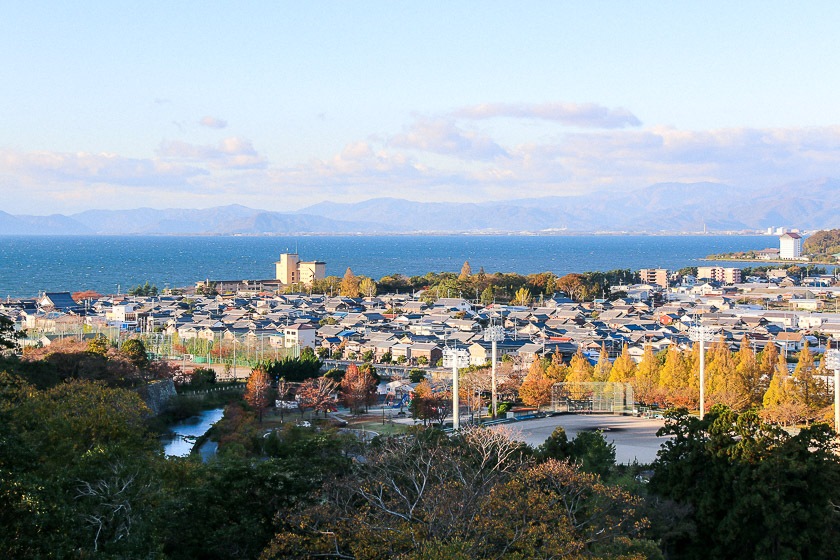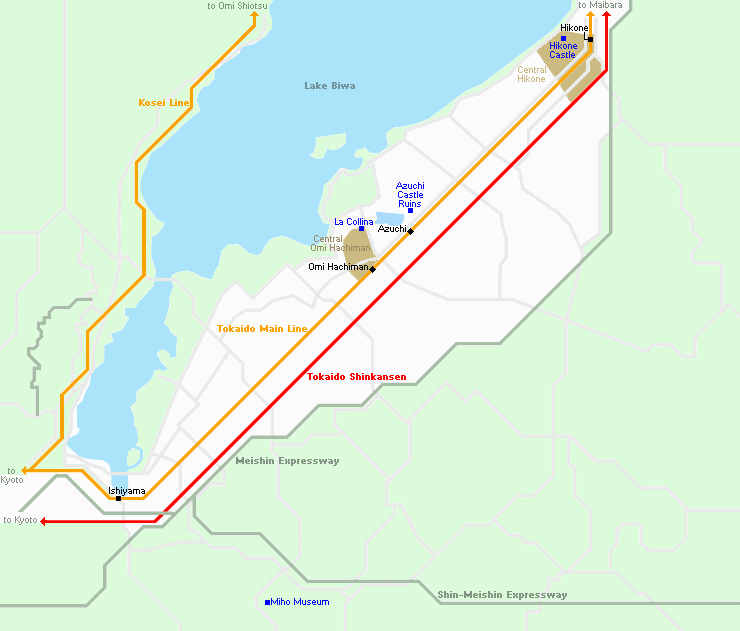Travel along Lake Biwa, Shiga

For our second Solo Female Travel trip, we head to Shiga Prefecture. The most well-known attraction in the prefecture is Lake Biwa, the largest lake in Japan, and I explored the area south of the lake for this 2-day trip. I stayed overnight in Hikone, a castle town, and visited the Miho Museum and the town of Omi Hachiman. This overnight trip is perfect for those who want a side trip outside of Kyoto or Osaka as Hikone is only 60 - 80 minutes away from these cities by trains. Our basic guide to traveling alone can be read here.

Day 1
The plan for the first day was to visit the Miho Museum before continuing towards Hikone where I would explore the castle town and stay the night there. I started my trip in the morning from Osaka where I was the day before, and took the local train to Ishiyama (970 yen one way, about 45 minutes from Osaka, frequent departures) where I would catch the bus bound for the Miho Museum (hourly departures between 9:00 and 14:00, 820 yen one way, about 50 minutes).
The beauty of the Miho Museum is its gorgeous architecture as well as its location in the mountains, and its collection of antiquities from around the world. Walking to the entrance of the museum is part of the highlight and experience at the museum, and visitors can enjoy seasonal foilage like cherry blossoms in the spring and autumn colors in the fall along the way in. Note that the museum is closed in the winter from December 3, 2018 to March 20, 2019 and will reopen in spring from March 21, 2019.

Unlike some of the bigger museums, the permanent collection at the Miho Museum is not extremely large with hundreds of works. Instead, there were fewer exhibits and I felt like I could give each piece sufficient time. In addition to the permanent collection, I also enjoyed the temporary special exhibitions which was about tea scoops (chashaku) when I was there. Despite being a temporary exhibition, the level of English explanations was very high and visitors would not be left out on the museum experience.
All in all, I ended up spending about two hours at the museum before catching the bus (hourly departures between 11:00 and 17:15, 820 yen one way, about 50 minutes) back to Ishiyama Station. From there, I got back on the train and headed for Hikone (840 yen one way, about 35-50 minutes, frequent departures).


Once at Hikone, I went straight to Hikone Castle which was an easy 15 minute stroll from the station. There are three main areas on the grounds of Hikone Castle: Genkyuen Garden, Hikone Castle and Hikone Castle Museum.

Genkyuen Garden was constructed in 1677 by the fourth feudal lord of Hikone and has two ponds and a number of walking trails. There are some buildings in Genkyuen where the lords would entertain their guests, and one of them is open to the public and offers tea and sweets. I had a good time walking through the garden and had a opportunity to see Hikone Castle.


Hikone Castle and the Hikone Castle Museum are close to one another, and I visited the museum before heading up to the castle. The museum exhibits many items from the private collection of the Ii family, who were the feudal lords of Hikone, including musical instruments and armor. In addition to the exhibits, the museum has an annex of a reconstruction of the palace buildings based on existing records. Despite being replicas, it was still a highlight for me to be able to enter and see the palace rooms that the feudal lords of past would've used for work and living.


One of the twelve remaining original castles in Japan, Hikone Castle has managed to survive without being destroyed since the end of the Edo Period. Visitors will find the castle keep relatively small and compact, and the stairs within narrow and steep. Those who make it up to the top will be rewarded with views of the castle grounds, Hikone city and Lake Biwa.


From there, I made for Castle Road, a shopping and dining district on the western end of the castle. I went for a walk in the area and popped into a few shops before getting dinner at a local restaurant serving up Omigyu, a wagyu breed from Shiga Prefecture.




Day 2
The plan for the second day of my trip was to head to Azuchi to check out the Azuchi Castle Ruins, then spending most of the day at Omi Hachiman before heading back to Kyoto.

From Hikone, I took the train to Azuchi (320 yen one way, around 20 minutes, frequent departures) and walked to the castle ruins from the station. The 20-minute walk took me past a mix of residential areas and rice and vegetable fields. Rental bicycles are available from shops outside the station, but I decided to go on a morning walk instead.

The Azuchi Castle Ruins was one of my favourite places this trip. The castle was commissioned by Oda Nobunaga in 1576 during his mission to unify Japan, and the keep, which was Japan's first castle keep, was completed in just three years. It is believed that the keep was one of the most beautiful and grand structures at that time, a 7-story, 33-meter tall wooden structure with colored tiles and a roof of gold. However, in another three years after that, the entire castle complex was razed to the ground after Oda Nobunaga was betrayed by his subordinate Akechi Mitsuhide and committed ritual suicide (seppuku) in Kyoto.
Today, stone foundations can be seen on the way to the main entrance, and one could get a sense of how big the castle grounds used to be. Note that there are lots of steps on the castle grounds and this site may not be suitable for those with trouble walking. Despite having seen Hikone Castle the day before, I was still wowed by the ruins of the Azuchi Castle even though only the stone foundations and steps remain. As I walked up the small 199-meter tall mountain the castle keep was built on, I imagined the grandeur of the castle and the buildings that may have lined the path I was walking on, and thought about how busy the place must have been back in the day. Entry to the castle ruins cost 700 yen and it is open from 9:00 to 16:00.








I got back on the train at Azuchi Station and took it one stop to Omi Hachiman (190 yen one way, 3 minutes, frequent departures) where I would spend the rest of the day. I kicked off my tour of Omi Hachiman by taking the bus (360 yen one way, about 15 minutes, 1-3 buses/hour) to La Collina Omihachiman, the beautiful flagship store of the Taneya Group which does both Japanese and Western style desserts. For those interested in design and architecture, La Collina Omihachiman is aesthetically pleasing, and the facility contains a number of unique buildings as well as a vegetable garden. In fact, the architect behind La Collina's landscape is Fujimori Terunobu, who did Shinshoji Temple in Fukuyama as well as the quirky teahouses in Chino, Nagano.









Then, it was back on the bus to head into central Omi Hachiman where I went for a boat cruise along the waterways in town, took the ropeway up Mt Hachiman where a castle once stood, checked out the grand Himure Hachimangu, a shrine that is said to have been built during the Heian Period. All these places were all within walking distance from one another, and was a good way to attempt to work off the calories consumed at La Collina earlier.












Before ending my trip, I took my last opportunity to eat some Omigyu nigiri as a final memento before taking a walk down Shinmachi-dori, Omi Hachiman's old merchant street, and walked back to Omi Hachiman Station. Just like that, my two-day trip came to an end. I visited some beautiful locations like the Miho Museum and La Collina Omihachiman, felt like I had uncovered some hidden secrets at the Azuchi Castle Ruins, checked a visit to one of Japan's original castle keeps off, and had pretty good vantage points of Lake Biwa all through this trip. I really enjoyed this trip and wouldn't mind doing it all over again, and perhaps next time include a visit to the museum that houses a reconstruction of a part of Azuchi Castle.
Till the next trip!






Getting There and Around
The main stations for accessing the spots above are Ishiyama, Omi Hachiman, Azuchi and Hikone, which are all on the Tokaido Main Line. Local buses from the stations provide access to Miho Museum and La Collina Omihachiman that are further away.






